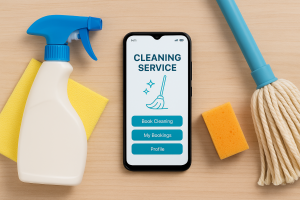 House cleaning has always been a hands-on business. For decades, it meant making phone calls to schedule services, using paper calendars to track bookings, and relying on word-of-mouth referrals to find reliable cleaners. But the past decade has reshaped the industry in ways that few could have predicted. From simple mobile apps to advanced automation tools, technology is changing how customers book a house cleaning service, how businesses operate, and even how the actual cleaning is done.
House cleaning has always been a hands-on business. For decades, it meant making phone calls to schedule services, using paper calendars to track bookings, and relying on word-of-mouth referrals to find reliable cleaners. But the past decade has reshaped the industry in ways that few could have predicted. From simple mobile apps to advanced automation tools, technology is changing how customers book a house cleaning service, how businesses operate, and even how the actual cleaning is done.
Easier Booking Through Apps
One of the biggest shifts is how customers find and schedule cleaning services. Instead of searching through directories or leaving voicemails, people can now compare services, check prices, and book appointments in just a few clicks.
These platforms often show ratings, reviews, and even background checks, which give customers confidence in who they are inviting into their homes. For cleaning companies, apps reduce time spent managing phone calls and allow for instant updates to schedules. Many apps also include automated reminders for customers, which helps reduce last-minute cancellations.
Smarter Scheduling and Management
Behind the scenes, software tools have become just as important. Cloud-based management systems help cleaning companies organize their workforce more effectively. GPS tracking enables businesses to monitor travel times and assign jobs based on location, reducing wasted hours between appointments.
For independent cleaners, digital scheduling tools eliminate the hassle of managing calendars manually. Clients can view available slots in real-time and book directly. This level of transparency keeps schedules full and reduces the risk of double bookings.
Cashless Payments
Payment has also been streamlined. Mobile wallets, online payment systems, and integrated billing within apps mean customers no longer need to leave cash on the counter. Automatic billing saves time for cleaners and creates a clear record of transactions, which is especially valuable for small business owners managing taxes and expenses.
For clients, paying online adds convenience and security. They can book, pay, and receive an invoice all from their phone, creating a seamless process that keeps them coming back.
Cleaning Robots and Automation
Technology isn’t just changing the business side—it’s changing how cleaning is done inside the home. Robotic vacuum cleaners were the first to gain traction, but the market has expanded to include window-cleaning robots, robotic mops, and even self-cleaning litter boxes.
These tools don’t replace professional cleaners, but they do change customer expectations. Many households now handle basic upkeep with smart devices and hire cleaning services for deeper, less frequent work. For cleaning companies, adopting automation tools can improve efficiency. High-powered vacuum robots or automated floor scrubbers can handle routine tasks while cleaners focus on detail work.
Green Technology and Smart Products
Technology has also played a role in the push for eco-friendly cleaning. Smart dispensers that measure the exact amount of cleaning solution reduce waste and save money. New vacuum systems feature HEPA filters that enhance air quality while reducing energy consumption.
Some companies now use data-driven tools to track supply usage, ensuring they only order what they need. Customers increasingly value sustainability, and technology helps cleaning businesses meet those expectations.
Remote Estimates and Virtual Consultations
Another change is how businesses win new clients. Instead of sending someone to a home for an estimate, companies can now offer virtual consultations. Customers upload photos or videos of their space, and cleaning professionals provide a quote without making a trip. This saves time, reduces travel costs, and makes it easier to serve clients in busy urban areas or remote locations.
Data and Customer Experience
Many cleaning companies are starting to use data in ways that were once limited to larger industries. By tracking client preferences, service frequency, and feedback, businesses can personalize services. For example, a system might remind a customer when it’s time for a seasonal deep clean or suggest an add-on service like carpet shampooing.
Challenges and Opportunities
Of course, adopting technology comes with challenges. Some independent cleaners may find it overwhelming to learn new systems. Less tech-savvy customers may still prefer phone calls and cash. And while automation reduces workload, it also requires an upfront investment that not every business can afford.
Still, the benefits often outweigh the obstacles. For workers, tools like automated scheduling reduce stress and free up time that can be spent on actual cleaning rather than administrative tasks.
The Future of House Cleaning
Looking ahead, the industry will likely see even more automation and integration. Smart homes may coordinate directly with cleaning companies, sending alerts when a service is needed. More advanced robots could handle tasks such as folding laundry or cleaning bathrooms, further altering the role of professional cleaners.
At the same time, technology won’t replace the personal touch that makes a cleaning service trustworthy. Customers value reliability, consistency, and attention to detail—things machines can’t fully replicate. What’s most likely is a blend: cleaners using technology to work smarter while still providing the human service customers expect.
